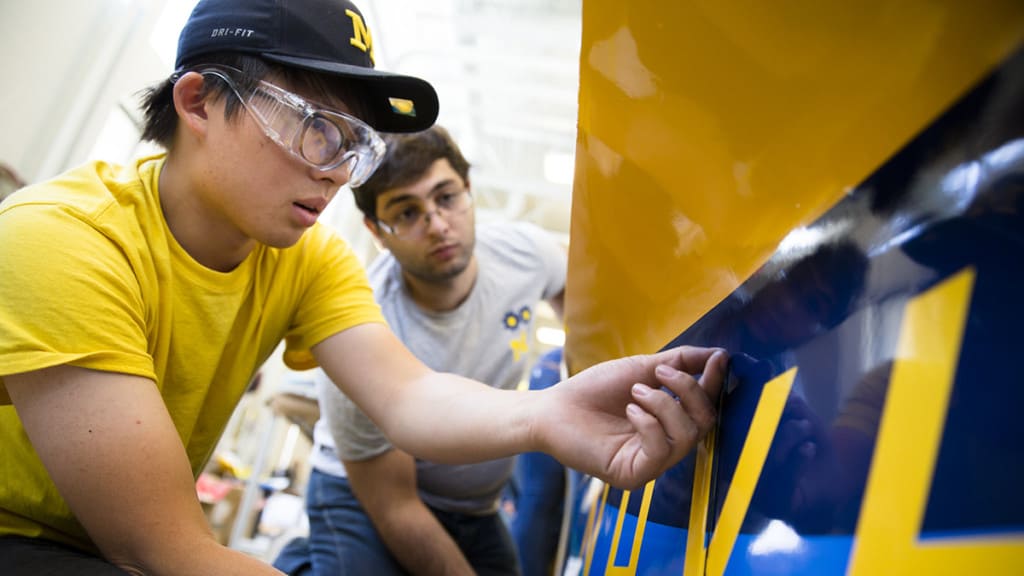
Multidisciplinary Centers
Engaging the range of expertise at Michigan Engineering allows researchers to better answer complex problems. Below, you will find the Multidisciplinary Centers where our faculty and students work.
Department of Defense Multidisciplinary University Research Initiative
Aerospace Engineering professor Venkat Raman was part of one of 28 research teams to receive funding through the Department of Defense 2022 Multidisciplinary University Research Initiative (MURI) awards program.
Led by Stanford University, researchers from U-M, University of Southern California, University of Virginia, University of Connecticut, and University of Central Florida are working together to explore novel propulsion systems for hypersonics.
The project focuses on multiphase detonations, which is the core physics that can enable a new generation of propulsion systems based on sustained detonations. The U-M contribution centers around numerical simulations of drop-shock interactions using a new approach for resolving the gas-liquid interface. There is considerable utility for such systems in hypersonics, which is a national priority, but also in conventional aircrafts and power generation systems.
Air Force Center of Excellence on Rocket Combustor Dynamics
Directed by Prof. Duraisamy in collaboration with MIT, Purdue and NYU, the goal of the center is to advance the state-of-the-art in Reduced Order Models (ROMs) and enable efficient prediction of transient events leading to the onset of instabilities in liquid fueled rocket combustion systems. The key outcomes are the following:
- ROMs of variable/adaptive fidelity derived from an organized hierarchy of higher fidelity simulations.
Integration of ROMs into a multi-fidelity model that can predict the stability characteristics of a full-scale LRE containing multiple injector elements. - Given a nominal engine configuration, end use is a methodology that designers can use to: a) Efficiently characterize combustion dynamics in O(days) on small cluster; b) Explore effect of parametric changes on QoIs
- Innovations to the science of reduced modeling of complex systems
- Engagement with AFRL researchers and exchange of knowledge, tools and data.
Center for Space Environment Modeling
The Center for Space Environment Modeling (CSEM) is directed by Professor Tamas Gombosi (AOSS). It is an interdisciplinary research organization of the College of Engineering, University of Michigan. CSEM is comprised of a tightly integrated group of faculty and students from the Department of Aerospace Engineering, the Department of Atmospheric, Oceanic and Space Sciences and the Department of Electrical Engineering and Computer Science.
FXB Center for Rotary and Fixed-Wing Air Vehicle Design (FXB CRFWAD)
The FXB Center for Rotary and Fixed-Wing Air Vehicle Design (FXB CRFWAD) includes professors Dennis Bernstein, Carlos Cesnik, Peretz Friedmann, Kenneth Powell, John Shaw and Anthony Waas. The Center focuses on innovative research on topics that represent barrier issues in rotary and fixed wing air vehicle design. The Center emphasizes the multidisciplinary nature of advanced aerospace vehicles. The research conducted and the faculty participating in the Center has varied over the years.
Currently, the Center is a framework for developing modeling, simulation and design software for rotary and fixed wing manned and unmanned vehicles where the aeromechanics of fluid-structure interaction plays an important role. The modest endowment preserves the continuity of the Center. The development and storage of the software developed, is facilitated by high end workstations. Extensive modeling and simulation software for analysis and design of on-blade control (including aero-servoelastic models of blades with active flaps, microflaps, and active flow control capable of modeling simultaneous vibration and noise reduction) have been developed within the framework of the Center. A typical examples are the AVINOR code that has been used in numerous helicopter vibration and noise reduction studies. Another software suite is HELIUM-UMICH for simulation of rotary wing vehicle ship landing. Another research focus of the Center is on hypersonic aeroelasticity and Aerothemoelasticity that has resulted in a computationally efficient framework software for analyzing hypersonic vehicle components. This framework, denoted HYPATE (stands for HYPersonic AeroThermoelasticity simulation Environment), based on an array of reduced order models (ROMs), it is capable of computationally efficient aerothermoelastic analysis as well as aerothermoelastic scaling of hypersonic vehicle components.
Since 2006 the FXB-CRFWAD has been a partner in the Vertical Lift Research Center of Excellence (VLRCOE), one of the three national Centers of Excellence in the rotary wing area. VLRCOE, funded by DOD and NASA, is led by Georgia Tech in a partnership with the University of Michigan, Washington University in St. Louis, Purdue University, and other institutions. Dr. Friedmann is an Associate Director of VLRCOE.
François-Xavier Bagnoud Flight Vehicle Institute
The François-Xavier Bagnoud Flight Vehicle Institute was founded in 2007 with the generous support of the François-Xavier Bagnoud Association. An integral part of the Aerospace Engineering Department, the Institute focuses on research and educational topics motivated by flight vehicles in an educational setting. These topics are broad in scope and include issues related to airplanes, helicopters, rockets, satellites and interplanetary missions. The institute also sponsors workshops, scholarly reports and visiting researchers and guest lectures, including the François-Xavier Bagnoud Lecture in Aerospace Engineering.
University of Michigan Space Institute
The Space Institute will coordinate space research and engineering efforts into a common framework, creating synergies between complementary efforts, enabling creative public-private partnerships in space, and mutualizing infrastructures needed for the University of Michigan to become an international leader in space research, engineering, policy, and exploration. The major thrusts of the University of Michigan Space Institute:
- Collaborating on space-related ideas and projects
- Bringing faculty together to generate new project ideas
- Organizing space-related courses and degree programs
- Helping students engage with space technology, science, policy, and commerce across campus
- Extending our current capabilities for large projects
- Using this institute to enable large-scale space-related projects, including spaceflight mission proposals
The leads from the Department of Aerospace Engineering include:
James Cutler – Lead for Education and Curriculum: Develops new courses for CubeSat design, build, and test experiences for students.
Mirko Gamba – Lead for External Engagement: Connects with alumni, friends, corporations, and government agencies.
GET INVOLVED
Be a part of research that pushes the boundaries of aerospace engineering.
